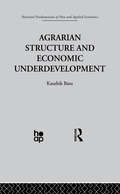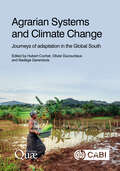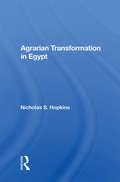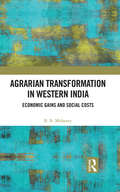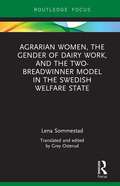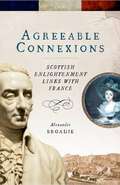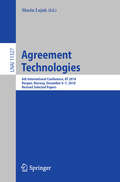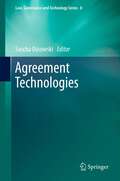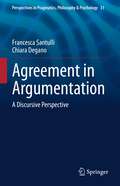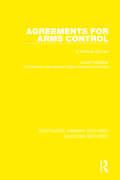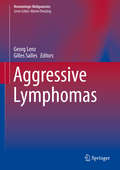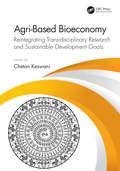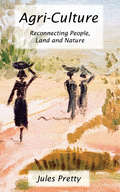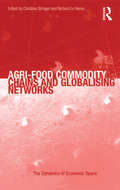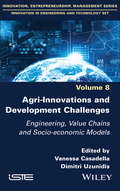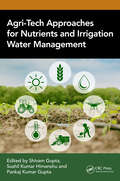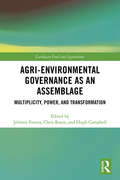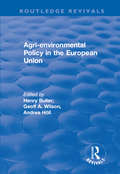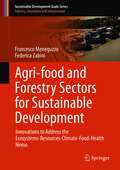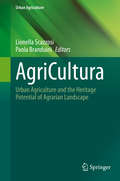- Table View
- List View
Agrarian Structure and Economic Underdevelopment
by K. BasuKaushik Basu (Cornell University) explores the relation between agrarian institutions and economic development.
Agrarian Systems and Climate Change: Journeys of adaptation in the Global South
by Hubert Cochet Olivier Ducourtieux Nadège GaramboisThis book examines the link between global change and impacts and adaptation at the local level, combining a systemic approach and connecting different scales of analysis. It unravels the complex ties between the scenarios developed at global, continental, regional scales of analysis and farmers' concrete experiences, lived at the territorial level. In addition to this great discrepancy in terms of scales of analysis and understanding of processes, there is a need to relate the multi-generational scale of possible climatic changes to that of agricultural practices carried out on the agricultural season level. Based on the detailed study and comparison of a dozen contrasting local situations in sub-Saharan Africa and South-East Asia, the authors highlight the processes and trajectories which explain the high exposure to the hazards of different groups of farmers, as well as their unequal capacity to adapt. They explain the causes of this vulnerability and illustrate the weight of past and current choices in terms of agricultural, environmental and trade policies. Finally, they present the adjustment modalities and the past and current transformations of peasant practices moving towards a reduction in exposure to hazards, a reduction in vulnerability, and better adaptation to global changes: climate change, demographic growth, increased competition for access to resources, changes in relative prices and market fluctuations, deregulation and decline in public support, etc. In conclusion, they outline possible paths in terms of adaptation and proposals for political measures to support producers.
Agrarian Transformation In Egypt
by Nicholas S. HopkinsThis book reflects the argument on agrarian transformation in Egypt. It focuses on the role of agricultural mechanization in the labor process in rural Egypt. The book emphasizes the changing role of the household and the relations between households, particularly the role of women and children. .
Agrarian Transformation in Western India: Economic Gains and Social Costs
by B. B. MohantyThis book examines the economic gains and social costs of agrarian transformation in India. The author looks at three phases of agrarian transformation: colonial, post- colonial, and neoliberal. This work combines macro and micro economic data, economic and noneconomic phenomena, and quantitative and qualitative aspects while exploring the context of historical and contemporary changes with special reference to Maharashtra in western India. It discusses regional disparities in agricultural development, issues of modernisation and social inequality, land owning among scheduled castes and tribes, women in agriculture, pattern of labour migration and farmer’s suicides, and documents the experiences and conditions of the rural poor and socially weaker sections to provide a comprehensive understanding of the significant changes in agrarian rural economy of western India. It also discusses contemporary development policy and practices and their consequences. Lucid and topical, this volume will be useful to scholars and researchers of agrarian studies, rural sociology, social history, agricultural economics, development studies, political economy, political studies, and public policy, as well as planning and policy experts.
Agrarian Women, the Gender of Dairy Work, and the Two-Breadwinner Model in the Swedish Welfare State
by Lena SommestadIn this volume, Lena Sommestad explores the significance of rural womanhood in the formation of Sweden’s gender-egalitarian welfare state in the early 20th century. Drawing on a rich array of documents, photographs, and interviews with women and men, she analyzes the changing gender division of labor in dairying and illuminates the dynamic processes and debates that shaped industrial workplaces. The book demonstrates the importance of rural women’s gainful labor and organized activism to Sweden’s citizenship-based social policies, which enabled married women to combine childrearing with breadwinning.
Agreeable Connexions: Scottish Enlightenment Links With France
by Alexander BroadieA history of Scotland&’s relationship with France during the Age of Englightenment. Scotland has played an immense role in European high culture through the centuries, and among its cultural links, none have been greater than those with France. This book shows that the connections with France stretch back deep into the Middle Ages, and continue without a break into the eighteenth century, the Age of Enlightenment. In one way or another all the major figures of the Scottish Enlightenment were in close relation to France. Though this book attends to the broad picture of the cultural links binding the two countries, the focus is on certain individuals, especially David Hume, Thomas Reid, Adam Smith, and Adam Ferguson, and certain of their French counterparts such as Montesquieu, Madame de Condorcet, Victor Cousin, and Theodore Jouffroy. Prominent among the areas under discussion are skepticism and common sense, morality and the role of sympathy, and civil society and the question of what constitutes good citizenship. The book should appeal to all with an interest in the broad sweep of Scottish cultural history and more particularly in the country&’s Age of Enlightenment and its links with France.
Agreement Technologies: 6th International Conference, At 2018, Bergen, Norway, December 6-7, 2018, Revised Selected Papers (Lecture Notes in Computer Science #11327)
by Marin LujakThis book constitutes the revised selected papers from the 6th International Conference on Agreement Technologies, AT 2018, held in Bergen, Norway, in December 2018. The 11 full papers and 6 short papers presented in this volume were carefully reviewed and selected from a total of 28 submissions. The papers discuss new ideas and techniques for the design, implementation and verification of next generation open distributed systems centered on the notion of agreement among computational agents. They are organized in the following topical sections: AT foundations and modelling of reasoning agents; argumentation and negotiation; coordination in open distributed systems with applications.
Agreement Technologies: Second International Conference, At 2013, Beijing, China, August 1-2, 2013. Proceedings (Law, Governance and Technology Series #8)
by Sascha OssowskiMore and more transactions, whether in business or related to leisure activities, are mediated automatically by computers and computer networks, and this trend is having a significant impact on the conception and design of new computer applications. The next generation of these applications will be based on software agents to which increasingly complex tasks can be delegated, and which interact with each other in sophisticated ways so as to forge agreements in the interest of their human users. The wide variety of technologies supporting this vision is the subject of this volume. It summarises the European Cooperation in Science and Technology (COST) Action project on Agreement Technologies (AT), during which approximately 200 researchers from 25 European countries, along with eight institutions from non-COST countries, cooperated as part of a number of working groups. The book is the first to provide a comprehensive overview of the emerging field of Agreement Technologies, written and coordinated by the leading researchers in the field. The results set out here are due for wide dissemination beyond the computer technology sector, involving law and social science as well.
Agreement in Argumentation: A Discursive Perspective (Perspectives in Pragmatics, Philosophy & Psychology #31)
by Francesca Santulli Chiara DeganoThis book explores the construction of agreement in the argumentative process, aiming to investigate how the activation of shared knowledge, values and beliefs leads to the creation of a common ground between the speaker and the audience in the pursuit of persuasion. In the first part of the book, the authors examine agreement from a historical and theoretical perspective, setting in relation major ancient and contemporary approaches to argumentation, with special regard for the notions of ethos, objects of agreement, starting points and topoi, all with a focus on their deployment in discourse. This is complemented with a compendium of linguistic resources that can be exploited for the discursive construction of agreement, offering a principled selection of structures across different levels of language description. The second part of the book is devoted to the investigation of actual uses of agreement in a choice of institutional genres within the domain of the US presidential elections: the Presidential Announcement, the TV debate and the Inaugural Address. Due to their political relevance and cultural salience, these genres provide an ideal interface for observing the interplay of discursive and argumentative components, against the backdrop of a shared cultural heritage, rich with intertextual references. The application of the theoretical framework developed in the first part of the book to the analysis of real political discourse carried out in the second is the distinguishing feature of this volume, making it of interest to linguists and argumentation scholars, as well as to political scientists and communicators.
Agreement to Kill
by Peter RabePunching Dixon had gotten Jake Spinner thrown in jail, but now that he’s out all he wants is a fresh start back on his farm. Suddenly Dixon is dead and Spinner is on the run, escaping town in the getaway car with Dixon’s assassin in the back seat! He knows the cops won’t believe his innocence. He knows his only chance is to keep the cold, clubfooted little killer known as Loma with him. Because Loma is his ticket to a new life. His respectable life shattered, Spinner figures the only ones who’ll take him in now are the guys who hired Loma. The choice is easy - until he meets Ann.
Agreements
by Oliver BlackCombining rigorous philosophical analysis with a deep knowledge of law, this study of agreements illuminates legal doctrine by philosophical theory and vice versa. Against the prevailing philosophical view of agreements, the book argues that they are to be understood in terms not of promises but of offer and acceptance. Topics covered include the obligations associated with agreements; the practical reasoning that leads parties to make and perform agreements; the relation between agreement and intention; and the reasons the State has to intervene in agreements. There are also separate chapters devoted to doctrines of agreement in the laws of contract, competition and conspiracy.
Agreements for Arms Control: A Critical Survey (Routledge Library Editions: Nuclear Security)
by Jozef Goldblat Stockholm International Peace Research InstituteOriginally published in 1982, this is the most comprehensive handbook on arms control ever published. It contains an analysis of the bilateral and multilateral agreements reached since World War II. An assessment is made of the extent to which each agreement has affected the arms race, reduced the likelihood of war or otherwise contributed to the overall goal of disarmament. Ongoing arms control negotiations are also analyzed. The complex problem of verification of compliance with arms control obligations is critically examined, and the shortcomings of the existing arrangements are pointed out. The critique is searching, objective and free of the usual biases of official government reports. The analysis of the arms control agreements is preceded by an historical overview, beginning with the Hague Peace Conferences, held at the turn of this century, through the League of Nations' attempts to bring about a universal reduction of armaments, to the activities of the United Nations in the field of arms regulation and general disarmament. The present arms control negotiating machinery is described. The texts of the relevant documents are reproduced for handy reference and the status of the implementation of the most important multilateral arms control agreements is presented in tabular form. Tables and figures facilitate the reading.
Agressive Lymphomas (Hematologic Malignancies)
by Georg Lenz Gilles SallesThis book summarizes current knowledge of the biology and molecular pathogenesis of aggressive lymphomas and reviews the state of the art in diagnostic and therapeutic strategies. The aim is both to provide the reader with a sound understanding of the very significant progress that has been achieved in the understanding and management of these malignancies over recent years and to facilitate appropriate choice of the therapeutic strategy in individual cases. The assessment of different prognostic parameters are clearly presented in order to permits effective risk stratification that impacts on treatment choice. Recent insights into lymphomagenesis are exemplified and may assist in identifying emerging therapeutic targets. The comprehensive and up-to-date nature of the book will make it an ideal reference for all physicians and researchers interested in lymphoma, including clinicians from various medical specialties, biologists, pathologists, radiologists and nuclear medicine specialist, as well as students.
Agri input Marketing in India
by Pingali Venugopal Ram KaundinyaThis book is a welcome addition to a much-needed conversation about the future of Indian agriculture. The two authors have brought their rich experiences to the readers in an elegant book that is surprisingly easy-to-read even as it is loaded with much-needed facts and innovative ideas. And while they modestly refer to this as a book about agri-inputs, they have cogently framed the bigger debate on the future of Indian agriculture, inviting all stakeholders, from farmers and government to input providers and dealers, to reflect on their critical role in crafting a more sustainable future.
Agri-Based Bioeconomy: Reintegrating Trans-disciplinary Research and Sustainable Development Goals
by Chetan KeswaniThis volume concentrates on the recent scientific advancements in agricultural biotechnology and reintegrates it with socio-economic, industrial and intellectual property aspects of agricultural biotechnology and its implications for accomplishing the sustainable development goals. Adopting a unique approach, this book amalgamates science and business perspectives from an insider’s viewpoint on the agro-biotech industry, laying the foundations for students and professionals alike. This book: Is a first of its kind by addressing the recent issues emerging in agro-based economies. Will be a single-point source for recent advancements in agro-based global bioeconomy. Empowers the utilization of biotechnology to address worldwide ecological issues by supporting sustainable resolutions for global agricultural markets. Gives both foundational hypothesis and functional direction on commercialization and regulatory issues. Empowers the usage of adaptable approaches that can adjust to and uphold socially and financially valuable agro-based technologies.
Agri-Culture: "Reconnecting People, Land and Nature"
by Jules Pretty'Refreshingly fluent narrative, brimming full of stories and metaphors' Tim O'Riordan, University of East Anglia, UK 'A great balance between storytelling and analysis which points to the critical need for gaining control over resources' Jacqueline Ashby, CIAT, Colombia 'Full of supporting evidence and clear arguments' Norman Uphoff, Cornell University, US 'A wonderful book, put together with such vision and passion' Mark Ritchie, Institute of Agriculture and Trade Policy, US 'A superb volume. This is a valuable monograph that all policy-makers, scholars and farmers must read to understand their roles and responsibilities' Vo-Tong Xuan, Angiang University, Vietnam 'Beautifully written. The implications of the book's ideas are deep and extensive' Julia Guivant, University of Florianopolis, Brazil Something is wrong with our agricultural and food systems. Despite great progress in increasing productivity in recent decades, hundreds of millions of people remain hungry and malnourished, and further millions suffer for eating too much food or the wrong sort. Agri-Culture envisages the expansion of a new form of food production and consumption founded on more ecological principles and in harmony with the cultures, knowledges and collective capacities of the producers themselves. It draws on many stories of successful agricultural transformation in developing and industrialized countries, but with a warning that true prosperity will depend on the radical reform of the institutions and policies that control global food futures, and fundamental changes in the way we think. The time has come for the next agricultural revolution.
Agri-Food Commodity Chains and Globalising Networks (The Dynamics of Economic Space)
by Richard Le HeronWithin the international agri-food community at least four theoretical targets are attracting increasing attention. They are: (1) the established notions of networks and commodity chains that are being revisited by way of critical engagement informed by the insights of in-depth empirical work, (2) the metrics of calculation and institutional embedding that underpin the rise and functionality of governance technologies, (3) the place of regional networking in creating conditions that make possible agri-food producer participation in local provisioning and supply, and (4) the geo-historical dimensions of interconnection and interdependency in the agri-food sphere. This volume brings together an interdisciplinary team of anthropologists, economists, business and management academics and geographers to examine a wide range of case studies illustrating various agri-food commodity chains and networks around the world and to discuss how they link globally.
Agri-Innovations and Development Challenges: Engineering, Value Chains and Socio-economic Models
by Dimitri Uzunidis Vanessa CasadellaInnovation is a major challenge for economic development and social progress. Faced with the ecological and food problems that the world is currently experiencing, the legitimacy of innovation takes on its full meaning, particularly in developing countries. As emphasized by international organizations (UN, FAO), building skills and abilities in the agricultural and food sectors are necessary when launching innovation processes for the benefit of suffering populations. This book deals with different experiences launched in many developing countries in these sectors and shows how local initiatives can provide answers to the pessimism of experts and the media. Multidisciplinary analysis and practices explain how collective work creates value chains that can foster local and national economic development. The authors revisit the innovation agri-food models that contribute to economic development. Agri-Innovations and Development Challenges is composed of general presentations of innovations applied in developing countries, as well as specific studies on the joint valorization of knowledge and experience in agri-food engineering
Agri-Tech Approaches for Nutrients and Irrigation Water Management
by Shivam Gupta, Sushil Kumar Himanshu and Pankaj Kumar GuptaThis book includes concepts, methodologies, and techniques used in soil nutrients and irrigation water management with regional and global prospects. This book accommodates up-to-date approaches to agricultural technologies along with future directions and compiles a wide range of articles ranging from soil moisture flow, nutrient dynamics, crop water estimation techniques, approaches to improve crop water productivity and soil health, crop simulation modeling, and remote sensing/GIS applications. The book also includes chapters on climate-resilient agriculture, advances in big data and machine-learning techniques, IoT, plasma technology, seed priming, and precision farming techniques and their environmental/economic impacts.Features:• Discusses applications sustainable technologies for soil nutrients and irrigation water management at multi-scale. • Covers application of remote sensing/GIS, big data and machine learning, IoT, plasma technology, seed priming, and precision farming techniques for nutrients and water management.• Reviews concepts, methodologies, and techniques being used in soil nutrients and irrigation water management. • Provides up-to-date information as well as future directions in the field of nutrients and agricultural water management.This book is aimed at researchers and graduate students in agriculture, water resources, environment, and irrigation engineering.
Agri-environmental Governance as an Assemblage: Multiplicity, Power, and Transformation (Earthscan Food and Agriculture)
by Hugh Campbell Jérémie Forney Chris RosinIn recent decades, the governance of the environment in agri-food systems has emerged as a crucial challenge. A multiplicity of actors have been enrolled in this process, with the private sector and civil society progressively becoming key components in a global context often described as neoliberalization. Agri-environmental governance (AEG) thus gathers a highly complex assemblage of actors and instruments, with multiple interrelations. This book addresses this complexity, challenging traditional modes of research and explanation in social science and agri-food studies. To do so, it draws on multiple theoretical and methodological insights, applied to case studies from Asia, Europe, Africa, and the Americas. It elaborates an emergent approach to AEG practices as assemblages, looking at the coming-together of multiple actors with diverse trajectories and objectives. The book lays the foundations for an encompassing theoretical framework that transcends pre-existing categories, as well as promoting innovative methodologies, which integrate the role of social actors – including scientists – in the construction of new assemblages. The chapters define, first, the multiplicities and agencies inherent to AEG assemblages. A second set tackles the question of the politics in AEG assemblages, where political hierarchies interweave with economic power and the search for more democratic and participative approaches. Finally, these insights are developed in the form of assemblage practice and methodology. The book challenges social scientists to confront the shortcomings of existing approaches and consider alternative answers to questions about environmental governance of agri-food systems.
Agri-environmental Policy in the European Union (Routledge Revivals)
by Geoff A. Wilson Henry Buller Andreas HöllThis title was first published in 2000: This volume provides a detailed examination of agri-environmental policy within ten European states. Individual chapters consider the agricultural and environmental policy contexts within each state and examine the range and significance of agri-environmental policy proposed in addition to their spatial and territorial impact, their policy-making implications and their consequences for the structures, institutions and actors of national farming policy both across and within national borders. Drawing from ten national profiles and the data sets provided, the book provides a comparative analysis of implementation trends, filling a gap in the literature on this topic. Taking European legislation as its starting point, the comparative section of the book examines how Member States have responded to EU imperatives in their budgetary commitments, in their implementation strategies and in the policy outputs that result. The study identifies similarities across European nations in the territorial and agricultural focus of agri-environmental policy and draws attention to the alternative.
Agri-food and Forestry Sectors for Sustainable Development: Innovations to Address the Ecosystems-Resources-Climate-Food-Health Nexus (Sustainable Development Goals Series)
by Francesco Meneguzzo Federica ZabiniThis book surveys state-of-the-art and prospective practices, methods and technologies in agri-food and forestry sectors to document the potential measurable improvements in areas of environmental management, food security, economic growth, social cohesion and human health at the local and global scale. With a focus on the ecosystems-resources-climate-food-health nexus as a framework towards achieving the UN Sustainable Development Goals applicable in these sectors, the book offers a portfolio of guidelines and standards that assesses the affordability, potential profitability and possible unintended consequences of interventions. The areas of intervention covered in the study include global and local forest resources management, safe wastewater reuse for irrigation, sustainable crop and plant protection (e.g. biopesticides, bioherbicides), carbon sequestration and emission reduction strategies, and safe processing methods for food and food waste (e.g. sustainable food preservatives and healthier food). The book is primarily intended for academics, professionals, and policymakers. The professional audience, including enterprises in the forestry, farming, food processing, healthcare and waste management sectors, will take advantage of the updated knowledge basis concerning the innovations in the respective practices, methods and technologies, including their feasibility, affordability and profitability, and policymakers will find useful the comprehensive review of these innovations which could be strategically promoted and deployed in the next decade, with the aim of achieving the UN Sustainable Development Goals.
AgriCultura: Urban Agriculture and the Heritage Potential of Agrarian Landscape (Urban Agriculture)
by Lionella Scazzosi Paola BranduiniThis book explains how cultural heritage can be a tool for enhancing urban agriculture and improving landscape and life quality. It cuts across the existing literature and fills the gaps between urban agriculture, considered as a food, social and environmental opportunity and cultural heritage, considered as resource. It focuses the role of the countryside for urban areas, in the history of the city and today. Its attention is on the quality for all areas, both outstanding, ordinary and degraded, as well as large, little or fragmented (European landscape convention 2000). It considers agricultural landscape as a system of tangible and intangible heritage components and relationships, to be retained, enhanced and transmit, in a process of inevitable but appropriate dynamic conservation and management over time (ICOMOS-IFLA Principles 2017). This book can benefit the collaboration among local players – such as farmers, citizens, associations, public institutions, stakeholders – in conserving and enhancing agrarian heritage and reinforcing the identity of places and people. It can strengthen collective action and generate positive effects on good large and local -scale management. The first part has a methodological character in order to enlighten the integrated approach between cultural heritage and urban agriculture. The second part exemplifies cases where the heritage has been recognised but not yet translated into concrete action. The third Part discloses ongoing process of co-construction, where policies have recognized the cultural, environmental and social meaning of urban agriculture as heritage. This book aims to reach scholars, local administrations, professionals, farmers and citizens. It involves many authors, many of whom are directly engaged with action-research in safeguarding and implementing the mutual interaction between urban agriculture activities and agrarian heritage.
AgriScience (5th edition)
by Jasper S. Lee Diana L. TurnerAgriScience, Fifth Edition, represents new student- and teacher-friendly approaches that blend science with the fundamentals of agriculture. Since agriculture is applied science, this is a highly useful and practical approach. Principles of science are presented and reinforced using agricultural applications. Of course, a broad interpretation of agriculture is used that includes crop and animal production as well as horticulture, forestry, marketing, and processing. The contents of AgriScience relate science information to useful applications in plant and animal production. Some things that sound complicated in the science classroom are used every day in the agriculture classroom. Practical applications result in academic connections that reinforce studies in related academic classes. This edition has updated and expanded content in a number of areas. The contents of the book have been reshaped to incorporate the Agriculture, Food and Natural Resources (AFNR) Career Cluster and the eight career pathways that are included.
AgriScience Explorations
by Jasper S. Lee Elizabeth M. Morgan Elizabeth WilsonNIMAC-sourced textbook
